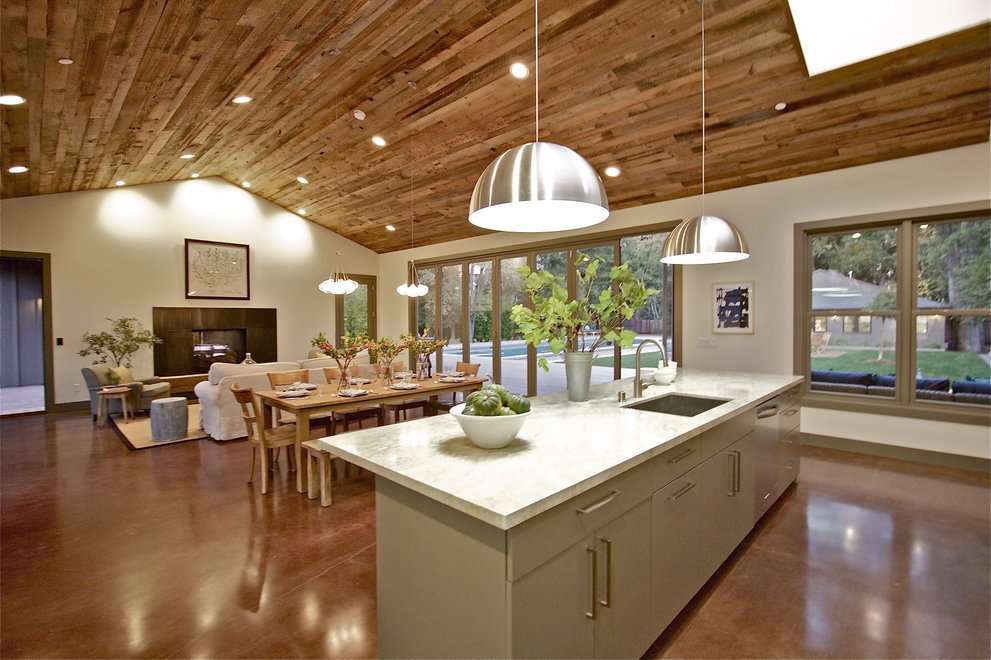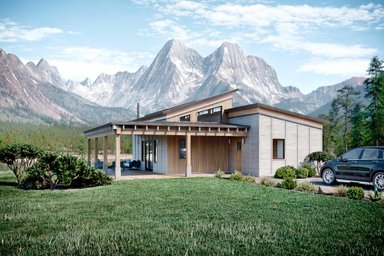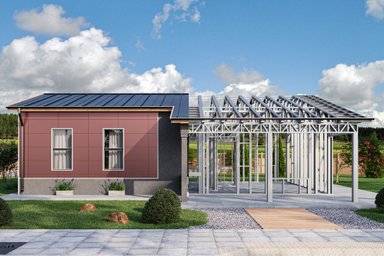To learn about salvaged wood and where it fits into home design we visited Evan Shively and his associate Carly Borman, a woodworker, at Shively's wood salvage yard, Arborica, in Marshall, California. Shively started out as a furniture designer, has been salvaging trees
for twenty years, and is a local legend sought out by architects, designers,
furniture makers and homeowners who are
looking for something special. [These examples at the Arborica showroom, include a magnificent slab of old growth redwood in the foreground, Claro walnut (also known as California black walnut) at rear left, and elm at rear right.]
How do you go about finding your “salvaged” wood?
Evan: We get calls from a wide variety of sources, especially about trees that have just fallen in a park or private property. In other cases trees that have to be removed for development. We like to see these trees given a second life.
What are some of the other wood products you make from salvaged wood?
Evan: We make flooring both as a solid product and as engineered flooring. We’ve found that eucalyptus makes great flooring and we offer this as an engineered wood product. We also get calls for interior paneling and for ceiling packages. Ceilings are often made from cypress, redwood or valley oak. Interior paneling is often milled tongue-and-groove as a solid product or produced as an engineered wood product. These boards can be made from any species.
How about beams, is there much call for these?
Evan: Some architects are ordering beam packages from a variety of species. The beams are decorative and give the feel of a timber frame or post and beam structure. The houses are double built meaning the posts and beams are not structural but give a feeling of solidity to the house as well as revealing the beauty of the wood.
How do you go about drying the slabs so that they are stable?
Evan: It generally takes about a year per inch. I have slabs that have been air drying between 2 and 10 years.
What do people like most about using salvaged wood?
Evan: People come to us first for the beauty of the wood and how it meets their needs. Many also appreciate the fact that we are salvaging and using a resource in a sustainable way. [At the Hotel Healsburg, the headboards and bedsteads
are made of salvaged bay laurel, photo courtesy Hotel Healdsburg.]
Which wood species are usually found in the home?
Carly: It is entirely to taste but generally people use hardwood species for interior surfaces such as countertops and dining room tables. Hardwood is more impervious to dents and scratches and there are a number of beautiful species.
Do people tend to prefer slabs with live or natural edges?
Carly: Again entirely to taste. Live edges often find their way on to coffee tables and sometimes countertops. We often offer slabs in pairs cut from the same tree. The pairs are used together to make interesting and beautiful dining room tables.
Where else in the home is your wood found?
Carly: Hardwoods are found in the dining room, in countertops, and in flooring. Softwoods such as redwood are often found in outdoor applications such as decking or siding. We also use cypress as an exterior paneling wood. NOTES: According to another wood source, MacBeath Hardwoods, with outlets in California and Utah, there is no standard for wood countertop thickness but
generally at least 1 1/2 inches is the minimum. The thicker the slab, the higher the cost as well as a longer drying
time. For finishing, some excellent FDA rated polyurethanes are safe for food, such as Emmet’s Good Wood Stuff. Some oils are also rated for food preparation.
As you think about where you might add the warmth and character of salvaged wood, consider using it as an
accent, as in this sliding barn door between the kitchen and the family room in Plan 888-18 by architect Nicholas Lee, or as a ceiling treatment, as above in the great room of Plan 888-17 also by Lee. For help with understanding and identifying wood species check out the helpful online Wood Database.
looking for something special. [These examples at the Arborica showroom, include a magnificent slab of old growth redwood in the foreground, Claro walnut (also known as California black walnut) at rear left, and elm at rear right.]
How do you go about finding your “salvaged” wood?
Evan: We get calls from a wide variety of sources, especially about trees that have just fallen in a park or private property. In other cases trees that have to be removed for development. We like to see these trees given a second life.
What are some of the other wood products you make from salvaged wood?
Evan: We make flooring both as a solid product and as engineered flooring. We’ve found that eucalyptus makes great flooring and we offer this as an engineered wood product. We also get calls for interior paneling and for ceiling packages. Ceilings are often made from cypress, redwood or valley oak. Interior paneling is often milled tongue-and-groove as a solid product or produced as an engineered wood product. These boards can be made from any species.
How about beams, is there much call for these?
Evan: Some architects are ordering beam packages from a variety of species. The beams are decorative and give the feel of a timber frame or post and beam structure. The houses are double built meaning the posts and beams are not structural but give a feeling of solidity to the house as well as revealing the beauty of the wood.
How do you go about drying the slabs so that they are stable?
Evan: It generally takes about a year per inch. I have slabs that have been air drying between 2 and 10 years.
What do people like most about using salvaged wood?
Evan: People come to us first for the beauty of the wood and how it meets their needs. Many also appreciate the fact that we are salvaging and using a resource in a sustainable way. [At the Hotel Healsburg, the headboards and bedsteads
are made of salvaged bay laurel, photo courtesy Hotel Healdsburg.]
Which wood species are usually found in the home?
Carly: It is entirely to taste but generally people use hardwood species for interior surfaces such as countertops and dining room tables. Hardwood is more impervious to dents and scratches and there are a number of beautiful species.
Do people tend to prefer slabs with live or natural edges?
Carly: Again entirely to taste. Live edges often find their way on to coffee tables and sometimes countertops. We often offer slabs in pairs cut from the same tree. The pairs are used together to make interesting and beautiful dining room tables.
Where else in the home is your wood found?
Carly: Hardwoods are found in the dining room, in countertops, and in flooring. Softwoods such as redwood are often found in outdoor applications such as decking or siding. We also use cypress as an exterior paneling wood.
As you think about where you might add the warmth and character of salvaged wood, consider using it as an
accent, as in this sliding barn door between the kitchen and the family room in Plan 888-18 by architect Nicholas Lee, or as a ceiling treatment, as above in the great room of Plan 888-17 also by Lee. For help with understanding and identifying wood species check out the helpful online Wood Database.






